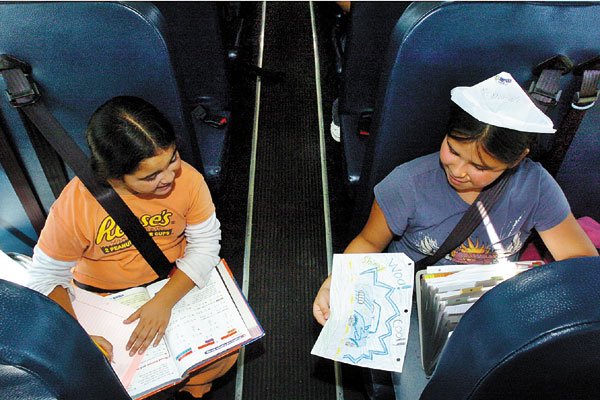The fog lights on top of two new school buses, the LED signals
that wrap around the sides and the automatic snow chains all
suggest the district’s new rides were not cheap. But the real cost
of the new buses is not the extras, rather it is safety and
environmental features.
Gilroy – The fog lights on top of two new school buses, the LED signals that wrap around the sides and the automatic snow chains all suggest the district’s new rides were not cheap. But the real cost of the new buses is not the extras, rather it is safety and environmental features.
Last month, the Gilroy Unified School District shelled out $298,000 for two buses with shoulder belts and cleaner-burning engines. The district is the first in South County to add buses with these features – required in all new buses by 2005 state legislation – to their fleet. While the purchase represents a move toward greater safety, it also presents a new burden on the district budget as the buses cost about 1.5 times as much for nearly half the number of seats.
“We lose 50 percent of the capacity, but we gain 50 percent of the price,” joked Darren Salo, district transportation manager.
The nearly $300,000 does not include about $20,000 the district will spend to install air-conditioning, he added. The buses do not have this feature, but had other optional extras, because the district piggybacked on a deal that another district had hammered out.
However, the district cannot get the buses – or the safety features – any cheaper. There are only three providers of buses in California, none of which offer the current 84-seat buses, and the buses purchased were the least expensive, Salo said.
The district is also unable to retrofit its 39 older buses in the fleet with shoulder belts because the floors lack needed strength. Also, the decreased capacity is because only two students can fit in a seat if they use shoulder belts whereas three students can fit if they are using lap belts. Therefore, retrofitting older buses would still decrease the capacity of the buses and require more buses to transport the same number of students.
In addition, the district will have to spend about $65,000 each year on gas, repairs and drivers’ salaries for every 150 students it buses. The decreased capacity of the new buses means the district will have to send out three new buses to service the same number of students that could have been served by two old buses. The district will have to pay the $65,000 in operating and staffing costs every year after the purchase of new buses.
These increased initial and recurring costs add up in future years as the district replaces older buses with newer buses. The district has grown by 5 percent during the past five years and to keep pace with future busing needs, it would have to purchase three new buses every five years. This translates to an initial expenditure of about $500,000 every five years and an additional yearly cost of about $65,000 in operating and staffing.
If this happens, the board of trustees might have to consider charging for busing, trustee Pat Midtgaard said.
“I think any district eventually looks at that,” she said.
The Morgan Hill Unified School District has been charging about $300 per year – or about $1.67 per round trip – for students to ride the bus since the late ’90s. However, the Gilroy school district is not at a point where it needs to charge yet, Midtgaard said.
In the meantime, the district will have to bear the costs, trustee Denise Apuzzo said. A student’s life is well worth any additional costs associated with busing.
“We try to save money where we can but when it comes to buying a safer school bus or a bus with less environmental impact, those things are more important,” she said.













